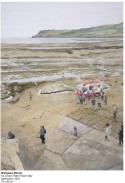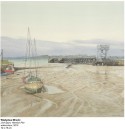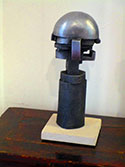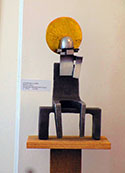WELCOME TO VIEW WITH SOCIAL DISTANCING 20TH JUNE TO 19TH JULY 2020 Wednesday to Sunday 10am to 5pm.
EASY ENTRANCE, WALK AROUND, EXIT THROUGH SCULPTURE GARDEN TO CAR PARK.
YOU ARE WELCOME TO COME ON THE FIRST DAY: PLEASE LET US KNOW AN APPROXIMATE TIME TO ALLOW FOR DISTANCING 10AM TO 5PM
Wednesday to Sunday 10am to 5pm or by appointment
Sizes quoted are of artworks. Where enquiries of prices are made on the gallery, the work is subject to availability and the price to change.Help us to make the exhibition a success. Keep your favourite postcard and then send on the others to friends you think may be interested.





















Sculptor of listed public sculpture Boudica, Turner Rise, Colchester









Once when writing a short passage for inclusion in a book on The Arborealists, in which examples of his own work appeared, Władysław Mirecki revealed his preference for bare trees. This is unusual. The glory of a tree, to most eyes, lies in its spring, summer or autumn foliage. Not in the stark exposure of its trunk, branches and twigs thrown up against a wintry grey sky. But it is in winter that, as Mirecki observes, trees reveal themselves, while also letting more of their surroundings come into view. He explains: ‘The context in which they lie is also of importance to me; the space around them, the leaf mould at their base. They do not exist in isolation, other trees live with them and creatures live upon them, and, while I’m making the picture, I too become almost tree-like myself; still and silent.’ As it happened a sudden severe illness interrupted Mirecki’s work on one of his large watercolours, Oak in Winter (2016), in which a single, bare tree, with its combination of strength and delicacy, reaches out and almost fills the full height and breadth of the paper. After the artist returned to work, it took months to complete, the tree’s own becoming echoing its maker’s return to health.
Mirecki is a landscape artist in a post-industrial age. He is attracted by settings where the man-made, be it a culvert or a disused railway line, and the natural come together. This is best see in Viaduct with Tank Traps (2014), where the receding viaduct is offset by a nondescript corner in which nature again tangles with the man-made, and the foreground iron railings have become broken with age or from misuse. It’s a complicated view, perhaps deliberately so, for it obliges the viewer to look hard and, in so doing, become ensnared in the composition. Yet the overall tonality is muted; even the disappearing viaduct, with its dramatic perspective, does not break the quietly subdued mood. Here and elsewhere, Mirecki’s work seems to offer a brooding threnody on the forgotten and overlooked. This can also be felt in front of Cement Works, Greenwich (2014-17), where the industrial setting is confronted head on. Few watercolours are as powerful as this. In different hands and at an earlier date, such a scene could have figured as a celebration of the significance of concrete to the making of the modern world. But in today’s climate such blinkered optimism would seem out of place. As it is, the heavy blue sky is feels slightly oppressive. It prepares us for the the spiked security fence, running across the foreground, its upright bars interrupted by a hose pipe or two which have become arbitrarily woven into its rigidity.
Given the scale and gravity of Mirecki’s paintings, it is astonishing to discover that his choice of medium is exclusively watercolour. When dealing with the elaborate vegetation discovered by the brook at the end of his garden, he can arrive at a degree of finish that almost gives this work the appearance of an oil painting. Nevertheless the lightness and transparency of watercolour is essential to the sensations generated by his art. For even when there is no obvious post-industrial motif in Mirecki’s art, there is often an eloquent mournfulness in his approach to landscape and, perhaps too, an underlying sense of loss. This vein of feeling positions him within a significant tradition. Ever since Albrecht Dürer created his famous print Melencholia, his winged figure, grounded by desolation, head resting on hand and eyes bright within a darkened face while all around is a litter of unused objects associated with science and art, many have been inspired by the notion, first found in neo-platonic writings, that melancholy is related to creativity. And that far from being a nostalgic or weak position, the melancholy view of life has integrity, and is often based on contemplative thought that is searching and realistic.
Mirecki has travelled far in his art, to reach the position he now occupies. It is indeed a timely moment in which to celebrate his achievement with this book and exhibition. Biographical facts about him are now readily available, but a few relevant details need repeating here. One if the fact that he was born in Chelmsford of Polish parentage, and, although he has painted in many other places, it is the Essex landscape, in which he still lives, that is at the heart of his oeuvre. Another fact is that he has always drawn or painted. His talent was recognised early on, during his schooldays. Favoured by two art teachers, he was encouraged to send work to children’s exhibitions mounted by the Royal Drawing Society and given full rein with regard to whatever materials he needed. This early encouragement may have brought out the contrarian in him as he finally opted not to go to art school but to study science at Kingston Polytechnic. Later, while continuing to paint and draw, he went through a variety of jobs, working as an industrial designer for Marconi’s, and also at one point pursuing his passion for railways by working in a railway museum. In 1986 he moved to the Chappel Galleries, in Chappel, Essex, first as a lodger, resident artist and handyman and then becoming co-proprietor and husband of Edna Battye, who had originated the business. Mirecki himself first began exhibiting in 1988 but much of his time for the next few years was spent helping others to exhibit.
A lack of confidence in what he was doing may also have held him back, for he was self-conscious about the fact that he had no training in art. Art schools vary and have a mixed reputation, but it is almost impossible to leave any art school without gaining some contextual and historical understanding of abstraction. Lacking this, Mirecki felt for some years uncertain as to what was and was not important in art; he had floundered, thinking himself not artistic enough to commit to art as a career or a vocation. After joining the Chappel Galleries, he still could not understand why many of the exhibiting artists seemed to him to hamper the expression in their art by ‘unnecessary splashes or dribbly twiggles’. To this day he tends to look with a critical eye at any too obviously arty effects, in paint or words. But his understanding of the visual language gained greater maturity through his conversations with one of the Chappel Galleries’ artists, Roderick Barrett, who taught at the Royal Academy Schools and had been elected President of the Colchester Artists’ Society, a post previously filled by John Nash and, before him, Cedric Morris. Barrett was too good a teacher to impose his own views on others but he drew to the fore Mirecki’s awareness of the complex ingredients in art, such as the need for balance, and honed his awareness of when a painting needed to be cleared of a wrong idea to make way for right things. Mirecki’s love of the intricate detail that realism permits still makes his suspicious of stylistic traits that give more importance to personal expression than to observation of the external world. His resolute stance means that, although he is accurately described as an East Anglia painter, he remains untouched by any influence from leading East Anglian artists. He remains the elephant in the room, for still today his name is absent in books about East Anglian art.
A significant breakthrough came with an invitation to have a solo exhibition in Nanjing, in the Jingsu Province Art Museum, in 1999. Although the show did not sell well, it marked a significant moment in Mirecki’s career in that it obliged him to stand back, reassess his work and ascertain the direction in which he now wished to go. In China he had seen many beautiful and exquisite things. Such finesse left him dissatisfied with some of his earlier plein air paintings which had been mostly produced on the spot. These now seemed to him too rushed, and so began his preference for working more in his studio than outdoors. Since the late 1980s he had exhibited regularly, but after his exhibition in China, he aimed higher in his choice of outlets for his work, thereby gaining a presence in leading exhibition societies, among then the Royal Watercolour Society, the Royal Institute and the Royal British Artists. Not only had he finally realised that he needed to take himself and his work seriously, but it would appear that his own artistic vision became more definite.
Mirecki, himself, makes no grand claims for his masterly pictures. ‘I paint what interests me,’ he says. His aim is not to promote a message, nor to dictate any specific emotional response through his art, but primarily to show you what he has seen. He has a gift not only for immediate detail but also for distant views and broad panoramas. His seascapes are, by any standards, outstanding examples of this genre. And if we look, say, at his View from Orford Castle (2014) or View from Clacton Pier (2014) we find a remarkable openness to his subjects. Mirecki’s concentrated attention makes it seem as if he has directly lifted the scenes in front of him and impressed them into paper by means of watercolours. Only close attention to the actual works reveals the thinking mind that has been judging what to leave in and what to take out. ‘Small things matter to me,’ Mirecki admits, and in View from Clacton Pier this is evident in the attention given to the touches of rust on the metal poles supporting the chains along the edge of the pier. In these pictures Mirecki fulfils W.H. Auden’s command – ‘Stand stable, here/And silent be’ – which, in the troubled year of 1936, formed part of his now famous poem ‘Look, stranger at this island now’.
One curious feature about these land- and seascapes is a sense of otherworldliness, which seems to arise from the quality of their light. Often Mirecki’s preferred light is the steady, unchanging light that comes through a north-facing window on an overcast day. Many of his paintings, and especially his seascapes, seem to belong to no particular time of day but are outside of time. This is partly because these large watercolours are labours of love and take a long time to paint. They do not, therefore, invite an impressionist concern with fast-changing light effects. Mirecki’s light does change from one picture to the next, according to the scene, climate and time of day, but it has an unnatural fixity, the benefit of which is that contributes to the stillness and duration that his work emits. He has found many subjects in and around Wakes Colne, where he lives, and in the Colne Valley. His subject may be only a bend in an empty road, with flat fields on both sides and a few bare trees in the middle distance. But I would not be surprised if in a hundred years’ time or less, folk will come looking for the precise spot at which pictures like Lane Road, Wakes Colne (2008), have been painted.
Several paintings in this current exhibition celebrate Mirecki’s pleasure in the texture, structure and open space found in a nearby barn. These pictures began with a commission from a local farmer. But Mirecki became so involved with this old building that he not only recorded different views of the interior, before and after reconstruction, but he decided to paint its ten doors, each one viewed twice, from the inside looking out, and then from the outside, looking in. What is it about this old barn, set off in two of these pictures by a spankingly new tractor, that appealed to the artist? Possibly a respect for the craftsmanship so openly portrayed in its structure? Also, perhaps, an affection for the character of decay and for the ever-changing vistas offered by those doors. But behind such remorseless activity also lies a rare dedication to the everyday world and to the environment. Standing in front of one of Mirecki’s paintings is like standing in front of those open doors in the barn, at the threshold of something not noticed or seen before which invites us to embark on a journey of looking. Mirecki is exceptional in his utter dedication to the task of painting, but there is also humour, too, in his work, as seen in the sudden glimpse of the spire of Salisbury Cathedral between the rooftops of two mundane modern red-brick houses, or in his sudden observance of bright red and white traffic cones sitting quietly down the side of a country lane. In this last painting the melancholy vein in his work disappears. It returns in those subjects we may have seen a hundred times before, yet never with the unexpected poetry that is this artist’s particular and subtle gift.
Frances Spalding
1956 Born Chelmsford, Essex of Polish parents. He is self-taught, having painted all his life including periods gaining his science degree at Kingston Polytechnic, London (1975-78); as an industrial designer and co-proprietor of Chappel Galleries (1986 – ).
1988 New English Art Club, Mall Galleries, London
1989 Epping Forest District Museum “Artists in Essex”
1989 Beecroft Art Gallery, Westcliffe on Sea, Essex 31st Open Exhibition
1990 Chappel Galleries, Essex Solo Exhibition
1991 Foyles Art Gallery, London
1992 Department of Transport Art Competition, Mall Galleries, London
1992 Deuxieme Salon Biennale de L’Aquarelle, Hirson, France (Chelmsford 1993)
1996 Chappel Galleries, Essex10th Anniversary Exhibition: Solo Exhibition
1997 Singer and Friedlander, Sunday Times Exhibition, London
1997 Beecroft Art Gallery, Essex: Open Exhibition
1998 Chappel Galleries, Essex: Solo Exhibition
1999 Jiangsu Provincial Art Gallery, Nanjing, China: Solo Exhibition
1999 Chappel Galleries, Essex Solo Exhibition
2002 Chappel Galleries, Essex Blyth Spirit “Walberswick Artists 1880-2000
2003 Chappel Galleries, Essex: Solo Exhibition
2003 WH Pattersons, London Christmas Mixed Exhibition
2004 Royal Academy, London Summer Exhibition
2004 WH Pattersons, London Christmas Mixed Exhibition
2004 Dove’s Barn, Suffolk
2006 Chappel Galleries, Essex: Solo Exhibition
2007 Royal Watercolour Society Open Competition, Bankside Gallery, London
2007 Royal Institute of Painters in Watercolours, Mall Galleries, London
2007 Royal Society of British Artists Annual Exhibition Mall Galleries, London: Winner of the Edward Wesson Award.
2007 Beecroft Art Gallery, Westcliffe on Sea, Essex 49th Essex Open Exhibition: Awarded Prize and Shirley Robson Bowl for the best watercolour
2007 Chappel Galleries, Essex ‘Southwold, the East Coast’
2007 Sunday Times/Kaupthing Singer & Friedlander Watercolour Competition, The Mall Galleries, London: 3rd Prize Winner
2007 Lynn Painter-Stainers, London
2007 Chichester Open Art Exhibition, Chichester
2007 Royal West of England Academy 155th Autumn Exhibition, Bristol
2007 New English Art Club, The Mall Galleries, London
2008 RWS/Sunday Times Watercolour Competition, Bankside Gallery, London
2008 Lynn Painter-Stainers, London (third prize winner)
2009 Chappel Galleries, Essex: Solo Exhibition
2009 Lynn Painter-Stainers, London
2010 Royal Institute of Painters in Water Colours 198th Annual Exhibition: The Mall Galleries, London
2010 Eastern Open, King’s Lynn Arts Centre
2010 The Sunday Times Watercolour Competition’s 23rd Year (2nd prize winner): The Mall Galleries, London
2010 Duncan Campbell Fine Art, London: Solo Exhibition
2011 Exhibition at Handelsbanken, Colchester; celebrating their new branch.
2011 Sunday Times/Smith Williamson Watercolour Competition 2011: The Mall Galleries, London
2011 Discerning Eye Exhibition: Mall Galleries, London
2012 Piers Feetham Gallery, London: Solo Exhibition
2012 Lyn Painter-Stainers, The Mall Galleries, London
2012 Chappel Galleries, Essex: Solo Exhibition
2012 Norwich Castle Open Art Show
2013 Chelmsford Borough Museum: Two Man Exhibition with Paul Rumsey
2013 Studio Eleven, Westcliff on Sea, Essex: ‘Kiss the Joy’ mixed exhibition
2013 Royal Society of British Artist, Annual Exhibition: The Mall Galleries, London (invited Artist)
2014 March 1st-30th ‘…just as it is…’ Chappel Galleries, Essex: Solo Exhibition
2014 September Sunday Times/ Smith Williamson Watercolour Competition: The Mall Galleries, London and touring
2015 Lyn Painter-Stainers: The Mall Galleries, London 16th to 21st February 1st prize winner
2015 Piers Feetham Gallery, London: Solo Exhibition 19th March to 11th April
2016 The Arborealists: St Barbe Museum and Art Gallery, Lymington, Hampshire
2017 John Russel Gallery, Ipswich, Suffolk: Solo Exhibition
2017 The Arborealists: Nature in Art Museum Art Gallery,Twigworth, Gloscester
2017 The Arborealists: Les Dortoirs des Moins, St Benoit, Poitiers, France
2018 March 3rd – 1st April Chappel Galleries, Essex: Solo exhibition
2018 The Arborealists: John Davies Gallery, Moreton-in-Marsh June dates tba
Black Swan Arts, Frome 20 July – 2 September
St Ives Society of Artists 29 September – 24 November
2019 Les Arborealistes: Collegiate Saint-Croix, Loudin
2019-2020 Arborealists at the National Memorial Arboretum, Alrewas, Staffordshire
2020 Coastal Scenes Exhibition 2020 Solo exhibition 20th June to 19th July Chappel Galleries, Essex
1989 Essex County Council
1999 Jiangsu Province Art Museum, People’s Republic of China
1999 Jiangsu Province Department of Culture, People’s Republic of China
2000/09 Chelmsford Museums, Essex
2000 Ipswich Borough Council Museums & Galleries, Suffolk
2012 Colchester and Ipswich Museums (on behalf of Colchester Borough Council)
2016 Beecroft Art Galley/Southend on Sea Museum, Essex
2016 Our Lady Immaculate, Catholic Primary School, Chelmsford, Essex
2018 Fitzwilliam Museum, Cambridge
2019 National Railway Museum, York
2000 February Edition, Jiangsu Art Monthly
2000 April Edition, Artists & Illustrators Magazine
2003 ‘A Walk in the Country’: Introduction by Richard Scott – 32pp Monograph, Published by Chappel Galleries, Essex
2006 “Southwold: An Earthly Paradise” by Geoffrey Munn.
2006 Wladyslaw Mirecki at Fifty: Introduction by Simon Frazer – 32pp Monograph, Published by Chappel Galleries, Essex
2006 BBC Television Programme: ‘Seven Man-made Wonders of the East’ featuring, Mirecki and his paintings of Chappel Viaduct
2003 2009 ‘On My Doorstep’: Introduction by Laura Gascoigne published by Chappel Galleries, Essex
2009 The Spectator “Winter Fine Arts” by Andrew Lambirth November issue
2009 Jackdaw Magazine “Easel Words” May/June issue
2009 The Artist Magazine “Masterclass” November issue
2009 Pratique des Arts, France issue no. 89 November 2009 – feature.
2010 Duncan Campbell exhibition brochure: Introduction by Andrew Lambirth
2012 Jackdaw Magazine Jan/Feb 2012 page 36 : News ‘That Beckham Tattoo’
2012 ‘Closely Observed’ Landscape – East Anglia and Beyond: Introduction by Andrew Wilton published by Piers Feetham Gallery, London.
2012 Lynn Painter Stainers catalogue page 11 ‘Holme Valley, Yorkshire’
2012 ‘Around and About: Introduction by David Lee editor of ‘Jackdaw’ published Chappel Galleries, Essex.
2014 ‘…just as it is…’ Introduction by Mark Curteis, Curator Chelmsford Museum, published by Chappel Galleries, Essex
2015 ‘New Landscape Watercolours’ Introduction by Andrew Lambirth, published by Piers Feetham Gallery
2016 The Arborealists – The Art of the Tree Introduction by Tim Craven, curator Southampton City Art Gallery published by Sansom & Co.
2017 Les Arborealists L’art des arbres
2018 “…Stand stable, here / And silent be…”: Introduction by Frances Spalding 32pp Monograph Published by Chappel Galleries, Essex
2018 2018 The Arborealists and other Painters, John Davies Gallery, Gloucestershire